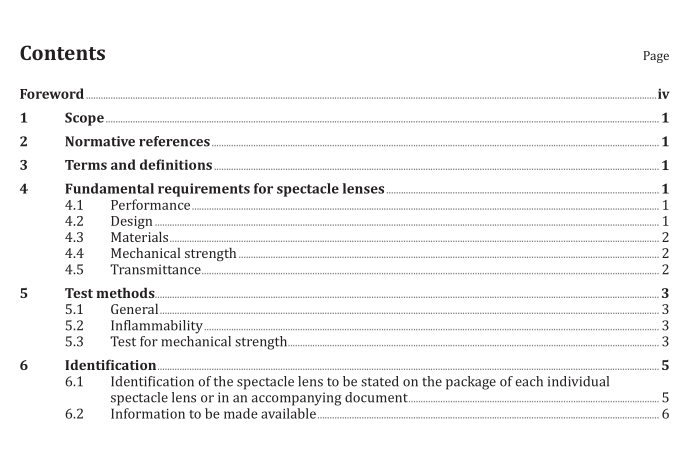ISO 14889 pdf download

ISO 14889 pdf download Ophthalmic optics — Spectacle lenses — Fundamental requirements for uncut finished lenses
Scope
This International Standard specifies fundamental requirements for uncut finished spectacle lensesThis International Standard is not applicable to protective spectacle lenses.
This International Standard takes precedence over the corresponding requirements of other standardsif differences exist.
2 Normative references
The following documents, in whole or in part, are normatively referenced in this document and areindispensable for its application. For dated references, only the edition cited applies. For undatedreferences, the latest edition of the referenced document (including any amendments) applies.
ISO 8980-1, Ophthalmic optics — Uncut finished spectacle lenses – Part 1: Specifications for single-visionand multifocal lenses
ISO 8980-2, Ophthalmic optics – Uncut finished spectacle lenses — Part 2: Specifications for progressivepower lenses
SO8980-3:2013,0phthalmic optics– Uncutfinishedspectaclelenses-Part3: Transmittancespecifications
and test methods
ISO 8980-4, Ophthalmic optics – Uncut finished spectacle lenses – Part 4: Specifications and test methodsfor anti-reflective coatings
ISO 13666, 0phthalmic optics – Spectacle lenses — VocabularyISO 21987, Ophthalmic optics — Mounted spectacle lenses
3 Terms and definitions
For the purposes ofthis document, the terms and definitions given in lSO 13666 and the following apply31manufacturer (ofan uncut finished spectacle lens)natural or legal person who places the uncut finished lens on the market
4 Fundamental requirements for spectacle lenses
4.1 Performance
In addition to the requirements specified in this International Standard, uncut finished lenses shallcomply with the relevant parts ofISO 8980, and mounted lenses shall comply with ISO 21987.
4.2 Design
Spectacle lenses shall be designed so that the overall risk associated with their use according to theconditions intended by the manufacturer, relative to the risk when the spectacle lenses are not used, is reduced to a level consistent with the materials used and compatible with the generally acknowledgedstate-of-the-art.
4.3 Materials
4.3.1Physiological compatibility
Lenses shall not be made from materials known to be physiologically incompatible or known to createallergic or toxic reactions among a significant proportion of wearers when the lenses are used asintended by the manufacturer.
4.3.2Inflammability
When the lens is tested as described in 5.2, there shall be no continued combustion after withdrawal ofthe test rod.
4.4 Mechanical strength
Uncut spectacle lenses shall withstand the quasi-static loading type test for minimum robustnessdescribed in 5.3.
The requirement for minimum robustness shall be satisfied if the spectacle lens withstands theapplication ofa 22 mm diameter steel ball with a force of (100 + 2) N, when tested as described in 5.3.
This test shall be carried out immediately after conditioning at a temperature of (23 + 5) C
After this test, the following defects shall not be apparent:
a) Lens fracture.
A spectacle lens shall be considered to have fractured if it has cracked through its entire thickness intotwo or more pieces or if more than 5 mg of the lens material has become detached from the surface.
b) Lens deformation.
A spectacle lens shall be considered to have been deformed if a mark has appeared on the white paperunderneath the lens.
NOTEIf the spectacle lens is intended for use for industrial or other purposes where mechanical hazardsexist, a higher level of mechanical strength or robustness may be required. lf eye protection is required, thespecific requirements are given in the appropriate International Standard.









